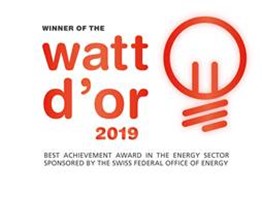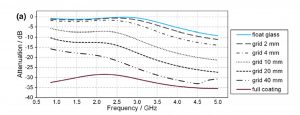The inverse pattern of a metallic mesh is represented by a conductive coating, which has been modified in order to create electrically insulated patches. Such a structure interacts with electromagnetic waves as a frequency-selective surface (FSS). Nanosecond laser ablation can be used to create a millimetric slit-pattern in a transparent conductive low-e coating (see Fig.12), achieving likewise a polyvalent effect of wavelength-selectivity: solar radiation in the UV-VIS-NIR spectral range is transmitted, heat radiation in the MIR range is reflected – keeping the thermal emissivity at low values – and the centimetre waves of mobile communication are transmitted [BOU2017] (see Fig.13). Hereby the transition wavelength from high transmission in the NIR to low transmission in the MIR is governed by the stratified structure in direction parallel to the substrate plane, while the transition wavelength from low transmission in the MIR to high transmission in the microwave domain is governed by the laser-scribed structure in direction normal to the substrate plane.
Our recent studies focus on the high frequency range up to 40GHz [FLE 2020] and on the polarization dependent behaviour which is relevant for Swisscom’s most recent multiple input – multiple output (MIMO) technology [BUR2023].
The novel microwave transmitting low-e coatings have originally been developed for mobile communications in trains [BUR2017], and are already in use in more than thirty BLS trains in Switzerland. More recently, we consider such laser-scribed low-e coatings also for buildings [FLO2022], since technologies for mobile communication between humans and even between objects (Internet of Things) are currently developing rapidly.
Selected references
[BOU2017] Bouvard O., Lanini M., Burnier L., Witte R., Cuttat B., Salvadè A., Schüler A., Structured transparent low emissivity coatings with high microwave transmission, (2017) Applied Physics A: Materials Science and Processing, 123 (1), art. no. 66 https://doi.org/10.1007/s00339-016-0701-8
[BUR2023] Burnier L., Jamaly N., Delaporte H., Durussel S., Fleury J., Schüler, A., Energy saving glazing with high MIMO performance, manuscript in preparation
[BUR2017] Burnier, L., Lanini, M., Bouvard, O., Scanferla, D., Varathan, A., Genoud, C., Marguerit, A., Cuttat, B., Dury, N., Witte, R., Salvadè, A., Schüler, A., Energy saving glazing with a wide band-pass FSS allowing mobile communication: Up-scaling and characterization, (2017) IET Microwaves, Antennas and Propagation, 11 (10), pp. 1449-1455 http://dx.doi.org/10.1049/iet-map.2016.0685
[FLE2020] Fleury, J., Lanini, M., Pose, C., Burnier, L., Salvadè, A., Zimmermann, E., Genoud, C., Schüler, A., Wide band-pass FSS with reduced periodicity for energy efficient windows at higher frequencies, Applied Physics A: Materials Science and Processing, 2020, 126(6), 417. https://doi.org/10.1007/s00339-020-03547-w
[FLO2022] Florio, P., Tendon, X., Fleury, J., Costantini C. , Schueler A., Scartezzini J.-L., Performance Assessment of a nZEB Carbon Neutral Living/Office Space and Its Integration into a District Energy-Hub, Energies 2022, 15(3), 793 https://doi.org/10.3390/en15030793
Internet links EPFL News:
https://actu.epfl.ch/news/train-windows-that-combine-mobile-reception-and-th/
https://actu.epfl.ch/news/bls-equips-29-trains-with-leso-pb-developed-techno/
https://actu.epfl.ch/news/leso-pb-technology-helps-win-the-2019-watt-d-or/
Award
Price of the Watt d’Or 2019 of the Swiss Federal Office of Energy
Category “energy-efficient mobility”
Retrofit of 36 NINA suburban trains with LESO-PB’s novel technology of microwave-transparent insulating glazing
In collaboration with BLS and the University of Basel
P.Oelhafen, C. Isenschmid, A. Schüler et al.


Fig. 1: Laser-ablation of a conductive low-e coating. [BOU2017]
a) Image of a line ablated by laser pulses with confocal laser microscopy. The dark area represents the coating. On the light part, the superimposition of the pulses can be observed.
b) Image of an intersection by confocal laser microscopy.
c) Observation by scanning electron microscopy (SEM) of the linewidth. On the side of the ablated area, some accumulation of material can be seen.
d) Details of the intersection by SEM. The width of the ablated line depends on the laser power and focus. In this study, it was kept between 35 and 40 microns.

Fig. 2: Measured attenuation in the mobile communication range (0.850–5 GHz) for the double glazing without coating (float glass), with full low-e coating (full coating) and with laser-structured low-e coatings (ablated lines width of w = 37 ± 2 mm, spacing D from 2 to 40 mm in grid pattern, respectively, 4–0.2% of ablated area). [BOU2017]